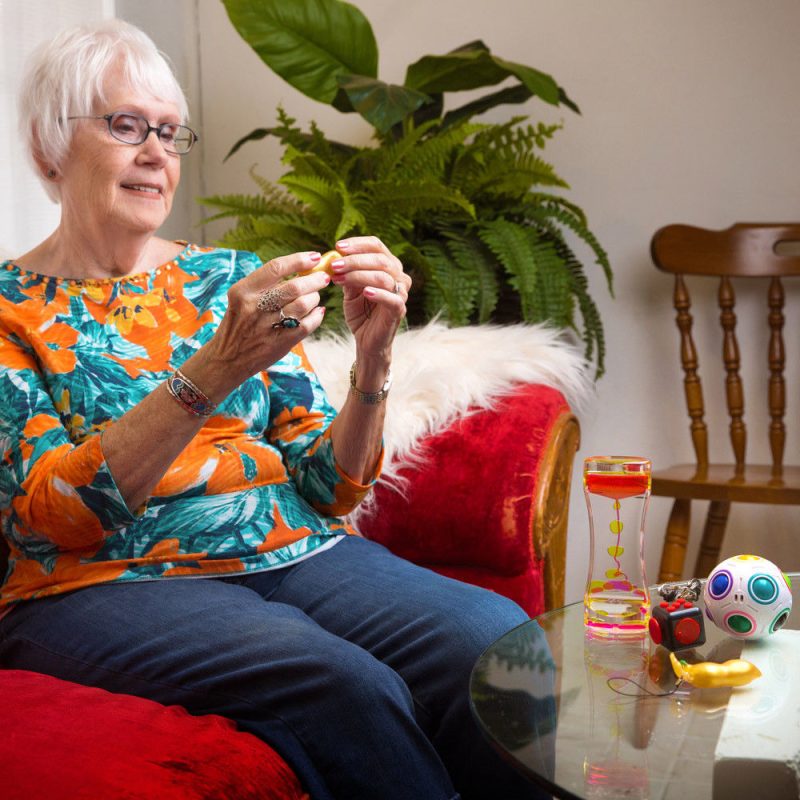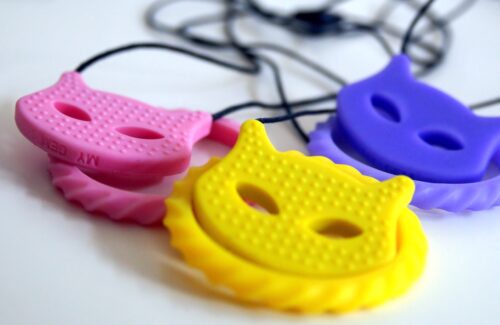What is the importance of stimulating the senses by, for example, sensory play material in people with dementia? Which sensory products can stimulate and stimulate people with dementia? Read it in this blog.
Stimulus processing in dementia
People with dementia have difficulty processing stimuli. Stimuli is everything that enters through the senses. It is most pleasant for most people to gain stimuli with your preferred sense, but this is often also the sense where stimuli can easily lead to overstimulation. And if your brain is damaged, for example by dementia, then the ability to filter out certain stimuli is often also damaged. It is then difficult to distinguish between what is important and what you can ignore.
No or too few stimuli is often not nice for people with dementia.
It leads them to look for stimuli. Such as breaking clothes, chewing on material that is not intended for it.
What is the importance of sensory play material in dementia?
People with dementia can be better activated by using all the senses in activities and contacts. Smells recall early memories in memory. A pungent taste can make someone enjoy extra. Many people who suffer from dementia are old: vision and hearing deteriorate. Glasses, a hearing aid, it helps, but is it enough? The more senses are used, the greater the chance of activation, experience, memories and feelings.
All pleasant stimuli contribute to the quality of life of people with dementia. By stimulating the senses, memories and emotions can be evoked in people with cognitive impairment. The purpose of this stimulation is to evoke positive memories, in order to keep the connection with family and the world around them as familiar as possible.

What is the effect of stimulating the senses on people with dementia?
By stimulating the senses of someone with dementia in a positive way, he or she will feel relaxed and safe. As mentioned, smells evoke memories, a pungent taste can make someone enjoy and a photo takes you back to old times. The more senses are stimulated, the greater the chance of activation, experience, memories and emotions. And the smaller the chance of anxiety and depression.
Furthermore, stimulating the senses can have a positive influence on the degree of alertness. Many people with dementia have problems in stimulus processing, which can be under- or overstimulation. Offering sensory play material can regulate alertness. It is important to look at the reaction of the person.
Tips for sensory toys in people with dementia
How do you stimulate the senses in people with dementia? The best way to challenge and stimulate people with dementia is to use sensory toys. Game materials that appeal to seeing, feeling, hearing, smelling.
Game material to feel
To activate the sense of touch, the sensory feeling circles are recommended. This set of sensory sensing circles consists of 10 round discs made of ultra soft flexible silicone – 5 large and 5 small with various textures/patterns. On the surface of each feel circle is a pattern that is distinctive and different from the rest of the set. Older people can feel the textures with hands and feet and thus discover the differences and their preferences.

Mimicking barefoot path
Mimicking a barefoot path? This is possible with the Muffik sensory puzzle mats. Another recommendation are also the sensory floor mats. These elderly people with dementia learn to deal with tactile stimuli. Use them in a trail, explore with the hands or the feet. They can be hung. The following textures are distinguished: Grass, glitter, sandpaper, plush, snakeskin and carpet. These sensory floor mats support the tactile, stimulus-seeking elderly. But they also support tactilely sensitive elderly people with dementia to gently take up the challenge with tactile stimuli. The non-slip back keeps the floor tiles in place and through the hole at the top, the floor mats can easily be hung on the wall.
Massage with a spiny ball
With the massage ball, you offer tactile stimuli and stimulate the processing of tactile information and the handling of touches. With the massage ball, also called spine ball, you offer tactile stimuli and stimulate the processing of tactile information and dealing with touches. The prickly ball feels hard. There are also spine balls in different sizes and hardnesses, give firm stimuli to skin and muscles and are easy to hold. They can be used, among other things, for massaging and activating muscles. Or to stimulate body awareness in elderly people with dementia

Game material to stimulate visually
Floor, wall or table visualization using a projector or floor tiles provide a challenging visual experience. The floor tiles with liquid and the interactive floor tile is a great invitation for elderly people with dementia to discover by moving.
The floor tiles with liquid are thin, and made of flowing colors that move due to the pressure exerted on them. Wonderful material for your person with dementia to discover and move with pleasure. Also very well used in a therapy practice. You also have the interactive floor tile , with which you create a unique sensory environment through a vivid display of color changes. The color stops at a specific color as soon as the person with dementia removes their foot from the sensory tile, creating a click-through feature that results in playful dance floor effects! A fantastic sensory tile that is versatile enough for use on the floor and on walls. The floor tile can be used in a snoezel room. But certainly also be used effectively to give people with dementia awareness of cause and effect and to encourage movement.
The magic table is also recommended: “People who normally sit in a chair and doze off become active. The game literally gets them moving and creates mutual interaction.”
Offering auditory stimuli
Music is an important tool in the guidance of people with dementia. Music can evoke memories and make them vivid. Music can be calming and relaxing for the demented elderly, but sometimes also evoke depressive feelings. Often family can advise on this. At bedtime, music can be used that has a calming effect on the person with dementia. For example, use the projector with speaker.
Looking for auditory toys, I can recommend the sensory balls and the sounds memory.

Make use of fragrance
Scents can support people with dementia in recalling memories. But you can also use the positive effect of aromatherapy to help demented elderly people relax and calm themselves. Certain scents can also be used activating in people with dementia. For example, you can use fragrance oil or, for example, an inhaler with aroma. When you use oil, you can apply some drops to the pillow to support sleep.
Activities to stimulate more senses
Preferably you try to stimulate more senses in people with dementia. A good example is the Crunchy Animal. This cool plush toy is filled with 100% organic buckwheat shells and some lavender flowers, which gives off a subtle calming aroma and an amazing tactile hand feeling. Various shapes hide in his body, this raccoon has a wooden ring with a soft woolen ball in his body. Just squeezing the stuffed animal and feeling the buckwheat caps move under the stretchy cotton surface creates a calming sensation. Due to the stretchy fabric, the crackling sound and the calming smell, the Crunchy Animal is ideal for discovering toys for elderly people with dementia who have less muscle tension and experience movement anxiety.
Another product that stimulates several senses at the same time is the multisensory gel Happy Senso. Happy senso is a dermatologically tested type of foamy product. Compare it to shaving cream. The demented elderly can use this to lie on the flat surface and experience the feeling, the crackling of the foam and the added smell sensation. In short, definitely recommended to activate understimulated elderly people.
Do you find this article interesting? Share it on social media.









